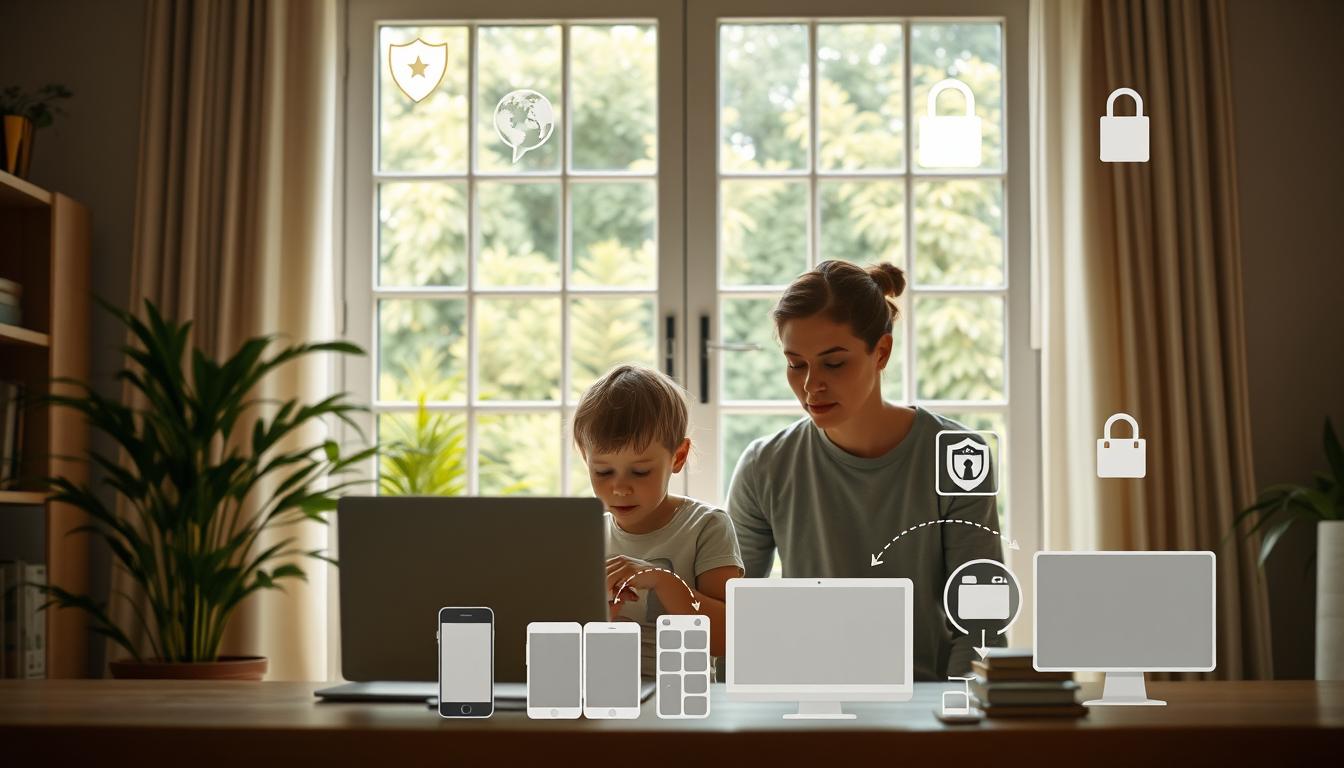In today’s digital world, keeping your child safe online is key. They might know how to use tech, but they might not know the dangers. Risks like cyberbullying, bad content, and predators are real and can hurt them.
By using good online safety tips, you can make a safer space for your kids. With the right knowledge and tools, you can help them stay safe and grow up to be good digital citizens. This guide will help you learn how to keep your family safe online.

Key Takeaways
- Recognize the importance of online safety for your child.
- Familiarize yourself with the common online dangers children face.
- Implement effective online safety tips for both parents and kids.
- Utilize parental control instruments to oversee your child’s online activity..
- Encourage open conversations about internet usage and safety.
- Be proactive in educating your children about personal information safety.
Understanding the Importance of Online Safety
The web is presently an enormous portion of our lives. It’s key for teens to know about online safety. Parents need to understand the dangers kids face online to protect them.
With new tech, kids might run into cyberbullying, bad content, and even online predators. Knowing these dangers is the first step to a safer internet.
Recognizing Common Online Risks
Parents need to know about online predators. Cyberbullying can hurt a child’s mental health. Tricks and phishing traps are getting more intelligent, focusing on teens.
Seeing bad content can change how kids think and act. Some big dangers include:
- Cyberbullying on social media.
- Online predators who trick kids.
- Scams that try to get personal info.
- Bad content found easily online.
The Role of Parents in Digital Safety
Learning about online dangers helps create a safe internet for teens. Parents should be involved in setting rules and creating a safe online space. It’s important to talk openly with your kids about their online life.
By talking around their online exercises, you’ll be able offer assistance to make them feel safe. This can greatly reduce the risks they face.

Online Safety Tips for Parents and Kids
Keeping your kids safe online is key. Use child-safe browsers and websites to start. Tools for monitoring help you watch their online actions without spying. Setting clear rules for online behavior teaches them responsibility.
Creating a Safe Online Environment
Protecting your kids’ online world is essential. Here are some tips:
- Use search engines like Kiddle or KidRex to block bad content.
- Install software that watches their online moves but keeps their privacy safe.
- Teach them not to share personal info online, stressing the importance of staying safe.
Encouraging Open Discussions About Online Behavior
Talking openly about their online life builds trust. It makes a difference for them to feel secure and share their concerns. Use these tips to guide your talks:
- Inquire about their favorite recreations or websites, appearing you care.
- Talk about online threats and how to stay safe or report issues.
- Encourage them to share their feelings and stories about their online time.

Setting Up Parental Controls
Setting up strong parental controls is key to keeping your kids safe online. There are many tools out there, each with its own strengths. It’s important to pick the right one for your family. This way, you can keep an eye on your child’s online activities while letting them explore safely.
Choosing the Right Parental Control Tools
When picking parental control tools, think about what your family needs. You can choose from software, device settings, or even family-friendly VPNs. Norton Family, Qustodio, and Net Nanny are great choices. They assist you to oversee your child’s online time and guarantee they get to secure apps.
Customizing Controls for Different Age Groups
As kids get older, their online interests change. It’s crucial to alter parental controls to fit their age and maturity. Younger kids might need simple rules, while teenagers can handle more complex settings. Tailoring controls helps your family stay safe and promotes responsible internet use.
Understanding the Limitations of Parental Controls
No tool can cover everything. Parental controls can only block and monitor based on your settings. They can’t replace talking to your kids about online safety. It’s vital to keep the discussion going to guarantee your child’s safety.

Implementing Screen Time Monitoring
Managing screen time is key for kids’ well-being in today’s digital world. By using screen time monitoring, you can help kids develop good digital habits. This ensures their tech use is balanced and meaningful. Setting clear rules for screen time helps kids do well both online and offline.
Establishing Healthy Screen Time Habits
Creating good screen time habits means setting limits and encouraging variety. Start by making a daily plan for device use and time. Here are some tips to improve their digital habits:
- Encourage regular breaks from screens to avoid fatigue.
- Advance elective exercises, such as open air play or reading.
- Set aside tech-free family time to foster communication and connection.
Using Apps for Effective Monitoring
Use monitoring apps to track your kids’ screen time better. These apps help measure use and start conversations about moderation. Apps like Qustodio or Net Nanny give insights into daily use. Using these apps lets you:
- Monitor app usage to identify distractions or problematic habits.
- Set screen time limits tailored to your child’s age and needs.
- Lock in in discussions almost the effect of intemperate screen time.
Educating Kids About Online Privacy
It’s crucial to understand kids’ online privacy today. As a parent, you’re key in teaching your kids about staying safe online. This part covers how to teach them about passwords and keeping personal info safe. It helps make their online time safer.
Teaching Strong Password Practices
Begin by showing why strong passwords are important. Clarify that each account ought to have a special password. A good password mixes letters, numbers, and symbols.
Tell your kids to avoid using easy-to-guess info like birthdays or pet names. Suggest using a password manager to keep track of these complex passwords safely.
Discussing Personal Information Safety
Teach your kids what personal info is and why it’s risky to share online. Explain that sharing details like their name, address, school, and phone number can be dangerous. Show them how to spot suspicious requests for their data, like in emails or on social media.
Use real-life examples to show the dangers of not keeping personal info safe. This helps them understand the importance of keeping their info secure.
Cyberbullying Prevention and Awareness
Cyberbullying is a big problem for kids and teens today. It’s important to know about it and teach others. Spotting the signs early can help protect your child from online bullies.
Identifying Signs of Cyberbullying
Look for small changes in your child’s behavior. These can show if they’re being bullied online. Some signs include:
- They start to avoid friends or activities they love.
- They’re secretive about their phone or computer use.
- They seem really upset or their self-confidence drops.
- They don’t want to go to school or do well in school.
Knowing these signs is key to stopping cyberbullying. It lets you help your child early on.
How to Support Your Child if They’re Being Bullied
It’s vital to create a safe space for your child to talk about cyberbullying. Start by having open talks about their online life. Here are some tips:
- Tune in to them and make them feel secure and trusted.
- Keep records of bullying, like screenshots and dates.
- Teach them to report bullying on social media and at school.
- Work with schools to form an arrangement to assist your child.
Using these tips can make the internet safer for your child. It helps them feel more confident online.
Conclusion
In today’s digital world, keeping your kids safe online is key. We’ve covered important tips for parents and kids to stay safe. By using parental controls and talking openly about online actions, you can make the internet safer for them.
As a parent, you need to keep up with technology and new online dangers. By knowing about risks and talking openly, you help your kids feel safe online. Trust and open talks help your kids come to you with online problems.
By being careful and taking steps to protect your kids, you can make their online world safer. Keep learning and adjusting to unused tech challenges. This way, your kids can enjoy the internet safely and learn from it.




GIPHY App Key not set. Please check settings